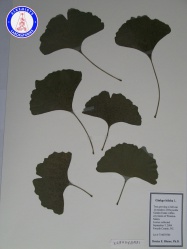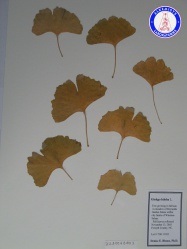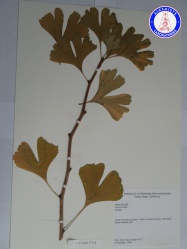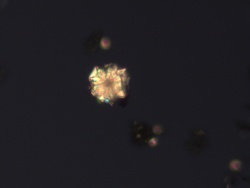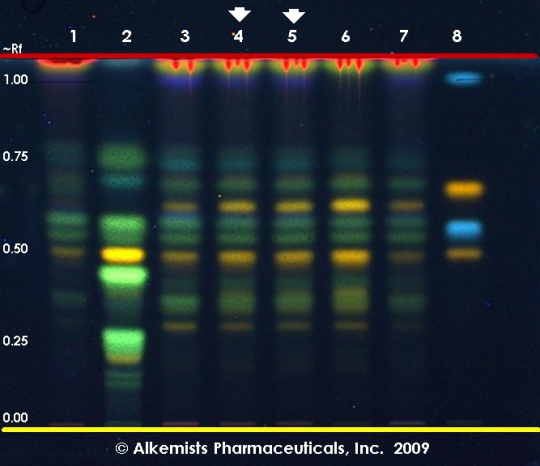Ginkgo biloba (leaf)
m (Italicized scientific name) |
(new layout omits British Pharmacopoeia, 2003 also see reference for microscopy) |
||
| Line 1: | Line 1: | ||
| − | = | + | {{DISPLAYTITLE:''Achillea millefolium'' (flower)}} |
| + | =Nomenclature= | ||
| − | + | =Botanical Voucher Specimen= | |
| − | + | {| border=1 | |
| + | | {{botcon |companyimage= AP-LOGO-Laboratories Crop - Copy.jpg | ||
| + | | companyURL= http://www.alkemist.com}} || {{botcon |companyimage= AP-LOGO-Laboratories Crop - Copy.jpg | ||
| + | | companyURL= http://www.alkemist.com}} || {{botcon |companyimage= AP-LOGO-Laboratories Crop - Copy.jpg | ||
| + | | companyURL= http://www.alkemist.com}} | ||
| + | |- | ||
| + | | {{botimg |mainimage= Ginkgo biloba X28004BMX1 A0138.jpg | ||
| + | |source= Botanical Voucher Specimen Library, Alkemists Laboratories http://www.alkemist.com}} | ||
| + | | {{botimg |mainimage= Ginkgo biloba X28004BMX3 A0462.jpg | ||
| + | |source= Botanical Voucher Specimen Library, Alkemists Laboratories http://www.alkemist.com}} | ||
| + | | {{botimg |mainimage= Ginkgo biloba XO1405JD1 A0463.jpg | ||
| + | |source= Botanical Voucher Specimen Library, Alkemists Laboratories http://www.alkemist.com}} | ||
| + | |} | ||
| − | + | =Organoleptic Characteristics= | |
| − | + | ||
| − | + | ||
| − | + | ||
| − | + | ||
| − | + | ||
| − | = | + | |
{{Macroscopy | source=Steven Yeager, Mountain Rose Herbs | {{Macroscopy | source=Steven Yeager, Mountain Rose Herbs | ||
| companyimage=Mrh logo.jpg | | companyimage=Mrh logo.jpg | ||
| companyURL=http://www.Mountain Rose Herbs.com | | companyURL=http://www.Mountain Rose Herbs.com | ||
| − | | description= | + | | description=Flavor: Slightly bitter. |
| − | + | Aroma: Slight. | |
| − | + | ||
| mainimage= | | mainimage= | ||
| caption1= | | caption1= | ||
| − | |||
| − | |||
| characteristics=Dark green to yellowish green; Leaves fan-shaped with tapering cuneate base; Center of apex notched and dividing blade into distinct lobes; Petiole long, with upper surface grooved. Leaf surface glabrous without midrib, and has wrinkled appearance. | }} | | characteristics=Dark green to yellowish green; Leaves fan-shaped with tapering cuneate base; Center of apex notched and dividing blade into distinct lobes; Petiole long, with upper surface grooved. Leaf surface glabrous without midrib, and has wrinkled appearance. | }} | ||
| − | {{Macroscopy | source= | + | =Macroscopic Descriptions= |
| − | + | {{Macroscopy | source=Steven Yeager, Mountain Rose Herbs | |
| − | | companyimage= | + | | companyimage=Mrh logo.jpg |
| − | | companyURL=http://www. | + | | companyURL=http://www.Mountain Rose Herbs.com |
| − | + | | description=Dark green to yellowish green; Leaves fan-shaped with tapering cuneate base; Center of apex notched and dividing blade into distinct lobes; Petiole long, with upper surface grooved. Leaf surface glabrous without midrib, and has wrinkled appearance. | }} | |
| − | | description= | + | =Microscopic Characteristics= |
| − | + | {| border=1 | |
| − | + | | {{botcon |companyimage= AP-LOGO-Laboratories Crop - Copy.jpg | |
| − | + | | companyURL= http://www.alkemist.com}} || {{botcon |companyimage= TMLogoK832X75.jpg | |
| − | + | | companyURL= http://www.traditionalmedicinals.com}} | |
| − | + | |- | |
| − | + | | {{botimg |mainimage= Ginkgo_micro_image_of_Stomata_with_large_guard_cells.jpg | |
| − | =Microscopic | + | |caption1=Stomate of Ginkgo biloba leaf with large thick-walled guard cells viewed under 1000x with Acidified Chloral Hydrate solution. Stomate of Ginkgo biloba leaf has large thick-walled guard cells [and] as well contains large rosettes of Calcium Oxalate crystals. |
| − | { | + | |source= Elan M. Sudberg, Alkemist Laboratories http://www.alkemist.com}} |
| − | + | | {{botimg |mainimage=Ginkgo polarized ca oxalate crystal, 200x.jpg | |
| − | | companyURL=http://www. | + | |caption1=Calcium oxalate crystal, polarized, 200X in glycerin:dionized water solution. Epidermis has irregularly sinuous walls, often with palisade parenchmya, stomata deeply sunken surrounded by 6-8 subsidiary cells, various sizes of calcium oxalate cluster crystals abundant. |
| − | | mainimage=Ginkgo_micro_image_of_Stomata_with_large_guard_cells.jpg | + | |source= Amy Brush, Traditional Medicinals http://www.traditionalmedicinals.com}} |
| − | + | |} | |
| − | + | ||
| − | + | ||
| − | + | ||
| − | + | ||
| − | + | ||
| − | + | ||
| − | + | ||
| − | + | ||
| − | + | ||
| − | + | ||
| − | + | ||
| − | + | ||
| − | + | ||
| − | + | ||
| − | + | ||
| − | = | + | =High Performance Thin Layer Chromatographic Identification= |
{{HPTLC | source=Elan M. Sudberg, Alkemist Laboratories | {{HPTLC | source=Elan M. Sudberg, Alkemist Laboratories | ||
| description=Ginkgo (leaf) ''Ginkgo biloba'' | | description=Ginkgo (leaf) ''Ginkgo biloba'' | ||
| Line 76: | Line 65: | ||
| }} | | }} | ||
| − | = | + | =Supplementary Information= |
| − | + | ||
{{Botanical | source=AHPA Known Adulterants | {{Botanical | source=AHPA Known Adulterants | ||
| companyimage=AHPA Logo.gif | | companyimage=AHPA Logo.gif | ||
| Line 85: | Line 73: | ||
| adulterants=Ginkgo (''Ginkgo biloba'') leaf extract with added flavonol glycosides or aglycones (e.g., rutin, quercetin, etc.). | | adulterants=Ginkgo (''Ginkgo biloba'') leaf extract with added flavonol glycosides or aglycones (e.g., rutin, quercetin, etc.). | ||
}} | }} | ||
| + | |||
| + | =Sources= | ||
| + | |||
| + | <references /> | ||
| + | [[Category:Botanical]][[Categoy:Microscopy]] | ||
Revision as of 18:57, 14 February 2014
Contents |
Nomenclature
Botanical Voucher Specimen
 |
 |
 |
|
|
|
|
Organoleptic Characteristics
|
Macroscopic Descriptions
|
Microscopic Characteristics
 |
 |
|
|
|
High Performance Thin Layer Chromatographic Identification
|
Ginkgo (leaf) Ginkgo biloba Lane Assignments Lane 1(3μl) Ginkgo biloba (leaf) (Vouchered Sample); Lane 2(3μl) Sophora japonica (fruit); Lane 3(3μl) Ginkgo biloba (leaf); Lane 4(3μl) Ginkgo biloba (leaf); Lane 5(3μl) Ginkgo biloba (leaf); Lane 6(3μl) Ginkgo biloba (leaf) (USA); Lane 7(3μl) Ginkgo biloba (leaf) (China) authenticated by macroscopic, microscopic &/or TLC studies according to the reference sources cited below held at Alkemists Pharmaceuticals, Costa Mesa, CA. Stationary Phase Silica gel 60, F254, 10 x 10 cm HPTLC plates Mobile Phase ethyl acetate: glacial acetic acid: formic acid: water [10/1.1/1.1/2.4] Sample Preparation Method 0.3 g + 3 ml 100% grain EtOH sonicated + heated @ 50° C ~ 1 hr. Detection Method Natural Product Reagent + PEG -> UV 365 nm Reference see British Pharmacopoeia, 2003
|
Supplementary Information
Ginkgo (leaf extract) (Ginkgo biloba) standardized to flavonol glycosides and terpenes.
General Characteristics AHPA recommends in its Known Adulterants list that appropriate steps be taken to assure that this raw material is free of the noted adulterant. Contact AHPA for additional information regarding relevant analytical methods or follow this link for more information.
Reported Adulterants Ginkgo (Ginkgo biloba) leaf extract with added flavonol glycosides or aglycones (e.g., rutin, quercetin, etc.).
Source: AHPA Known Adulterants [9]
Sources
- ↑ Botanical Voucher Specimen Library, Alkemists Laboratories http://www.alkemist.com
- ↑ Botanical Voucher Specimen Library, Alkemists Laboratories http://www.alkemist.com
- ↑ Botanical Voucher Specimen Library, Alkemists Laboratories http://www.alkemist.com
- ↑ Steven Yeager, Mountain Rose Herbs http://www.Mountain Rose Herbs.com
- ↑ Steven Yeager, Mountain Rose Herbs http://www.Mountain Rose Herbs.com
- ↑ Elan M. Sudberg, Alkemist Laboratories http://www.alkemist.com
- ↑ Amy Brush, Traditional Medicinals http://www.traditionalmedicinals.com
- ↑ Elan M. Sudberg, Alkemist Laboratories http://www.alkemist.com
- ↑ AHPA Known Adulterants http://www.ahpa.org/
